Greenpoint Snail (Trachycystis rariplicata)
The Greenpoint Snail, described in 1849, is known exclusively from Green Point, today a suburb of Cape Town, South Africa.
This species is now extinct, and its extinction is sometimes attributed to the introduction of an invasive Mediterranean snail species, the Mediterranean Coastal Snail (Theba pisana (Müller)), which is now very abundant in that region. However, the true reasons for its disappearance are rather found in the massive habitat destruction by swamp drainage, building of sports fields, houses and other extensive transformations.
***
syn. Helix rariplicata Pfeiffer, Pella rariplicata (Pfeiffer)
*********************
edited: 22.08.2022
Tag Archives: Western Cape
Phylica schlechteri Pillans
Orangekloof Hardleaf (Phylica schlechteri)
Thia species was restricted to a very small area along the southwestern coast of the Western Cape Province of South Africa, where it was found growing in so-called sandstone fynbos.
The species has not been found since over 100 years and is very probably extinct. [1]
*********************
References:
[1] N. A. Helme; T. H. Trinder-Smith: The endemic flora of the cape Peninsula, South africa. South African Journal of Botany 72: 205-210. 2005
*********************
edited: 04.11.2020
Allocotocerus mixtus (Orchymont)
Table Mountain Water Scavenger Beetle (Allocotocerus mixtus)
The Table Mountain Water Scavenger Beetle was described in 1939; the species was endemic to the Table Mountain next to Cape Town in the Western Cape Province of South Africa.
The species has never been found since and is likely extinct now. [1]
***
The species is often found under the name of Allocotocerus mistus (Orchymont) containing a typo.
*********************
References:
[1] A. G. Rebelo; P. M. Holmes; C. Dorse; J. Wood: Impacts of urbanization in a biodiversity hotspot: Conservation challenges in Metropolitan Cape Town. South African Journal of Botany 77: 20-35. 2011
*********************
edited: 16.02.2024
Cephalophyllum parvulum (Schltr.) H. E. K. Hartmann
Small Ice Plant (Cephalophyllum parvulum)
This species was restricted to the Fynbos in the clanwilliam area in the Western Cape Province of South Africa; most of the this region has been developed for urban or agricultural use.
The Small Ice Plant is now considered extinct.
*********************
edited: 01.11.2020
Erica velitaris Salisb.
Armed Heath (Erica velitaris)
The Armed Heath is one of numerous heath species that are endemic to the Western Cape Province of South Africa, its taxonomic status is not fully clearified and it may in fact be a hybrid, however, there are two additional varieties that sometimes are accepted, Erica velitaris var. hemisphaerica Bolus, and Erica velitaris var. parvibracteata Bolus.
If this is in fact a true species with three subspecies, then the nominate may be extinct.
*********************
References:
[1] N. A. Helme; T. H. Trinder-Smith: The endemic flora of the Cape Peninsula, South africa. South African Journal of Botany 72: 205-210. 2005
*********************
edited: 18.05.2019
Erepsia promontorii L. Bolus
Cape Erepsia (Erepsia promontorii)
The little Cape Erepsia was known to occur at three areas on the cape Peninsula, South Africa; one was Cape Point, a cliff at the southern end of the Cape Peninsula, the other two were at the town of Hermanus and at Sea Point, today a densely populated suburban of Cape Town.
The species was last seen in 1950 and is believed to be possibly extinct, howevere, it was found growing in the so-called Hangklip Sand Fynbos, a habitat that still exists at least at Cape Point, thus there is still some hope that this species might be rediscovered some day.
*********************
edited: 09.09.2019
Leucadendron spirale (Salisb. ex Knight) I. Williams
Wolseley Conebush (Leucadendron spirale)
The Wolseley Conebush was described in 1809; it was restricted to a small area in the Lower Breede River Valley in the Western Cape Province, South Africa.
The species was last seen in 1933 and is now considered extinct.
*********************
edited: 17.02.2024
Willdenowia affinis Pillans
Table Mountain Willdenowia (Willdenowia affinis)
This species is known from the type material only which was collected in 1918 from the northern slopes of the Table Mountain near Cape Town in the Western Cape province of South Africa.
The area in which this plant was found is now overgrown by alien plants and the species was never found since the collection of the type and is thus most likely extinct. [1]
*********************
References:
[1] N. A. Helme; T. H. Trinder-Smith: The endemic flora of the cape Peninsula, South africa. South African Journal of Botany 72: 205-210. 2005
*********************
edited: 26.04.2021
Felicia annectens (Harv.) Grau
Annexing Cape Daisy (Felicia annectens)
This species, described in 1865, was only ever known from four localities on the Cape Peninsula of southern South Africa.
Annexing Cape Daisy was an annual, up to 15 cm tall, branched or unbranched delicate herb with about 2 cm long and 0.4 cm wide leaves, it had flower stalks up to 6 cm long with blue flowers.
The species, whose taxonomical status is somewhat questionable, is most closely related to the Cape Daisy (Felicia bergeriana (Spreng.) O. Hoffm.) (see photo below); it was apparently last recorded in 1915 and is thought to be extinct.
*********************
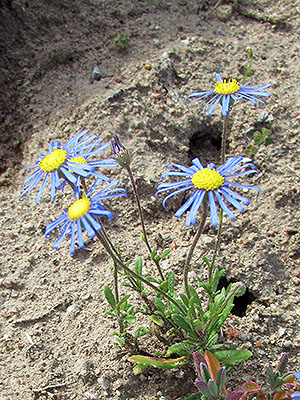
Photo: Chris Vynbos
https://www.inaturalist.org/people/vynbos
https://creativecommons.org/licenses/by-sa/4.0/
*********************
edited: 15.01.2024
Aspalathus variegata Eckl. & Zeyh.
The Variegated Aspalathus was described in 1836; it was endemic to a small locality on the Cape Flats in southwestern South Africa, a area that now is taken by the city of Cape Town.
The species was last found in 1898 and is now extinct.
*********************
References:
[1] N. A. Helme; T. H. Trinder-Smith: The endemic flora of the cape Peninsula, South Africa. South African Journal of Botany 72: 205-210. 2005
*********************
edited: 14.11.2021
Erica pyramidalis Aiton
Pyramid Heath (Erica pyramidalis)
The Pyramid Heath was restricted to what today is the city of Cape Town in the Western Cape Province, South Africa.
The species disappeared at the beginning of the 20th century due to the destruction of its habitat by the expanding city, and, despite the fact that the species was even cultivated for some time it is now considered extinct. [1]
*********************
References:
[1] N. A. Helme; T. H. Trinder-Smith: The endemic flora of the Cape Peninsula, South africa. South African Journal of Botany 72: 205-210. 2005
*********************
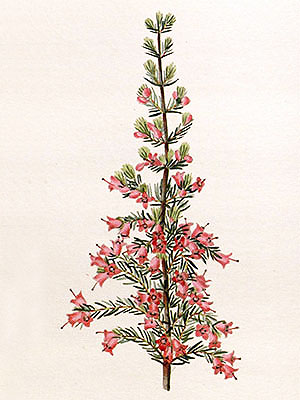
(public domain)
*********************
edited: 18.05.2019
Disa ecalcarata (G. J. Lewis) H. P. Linder
Spurless Disa (Disa ecalcarata)
This species is known only from the type material which was collected in 1947 at an unspecified location on the Cape Peninsula, South Africa.
The species was never found again and is considered extinct, it might, however, be a hybrid or an aberrant form of another species.
*********************
edited: 15.05.2021
Disa forcipata Schltr.
Forceps-shaped Disa (Disa forcipata)
This species is known from the type alone, which was collected in 1870 at an unknown place probably in the Knysna area of the Western Cape Province, South Africa.
The species was never found again and is considered extinct.
*********************
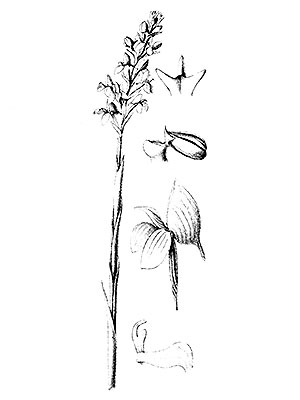
(public domain)
*********************
edited: 15.05.2021
Algophilus lathridoides Zimmerman
Table Mountain Crawling Water Beetle (Algophilus lathridoides)
The Table Mountain Crawling Water Beetle, described in the year 1924, is known only from the type locality near Simons Town in the Western Cape Province of South Africa.
The species was obviously not found during recent field searches and is considered most probably extinct.
*********************
References:
[1] T. R. New: Beetle Conservation. Springer 2007
[2] A. G. Rebelo; P. M. Holmes; C. Dorse; J. Wood: Impacts of urbanization in a biodiversity hotspot: Conservation challenges in Metropolitan Cape Town. South African Journal of Botany 77: 20-35. 2011
*********************
edited: 01.11.2020
Hesperantha saldanhae Goldblatt
Vredenburg Hesperantha (Hesperantha saldanhae)
This species is known exclusively from the type collection from 1964.
The Vredenburg Hesperantha was found on granite rocks, which are located at the edge of the town of Vredenburg in the Western Cape Province, South Africa.
The species was never found since and is considered most likely extinct.
***
The photo shows one of the many beautiful species of this genus, the Red Hesperantha (Hesperantha coccinea ((Backh. & Harv.) Goldblatt & J. C. Manning)).
*********************
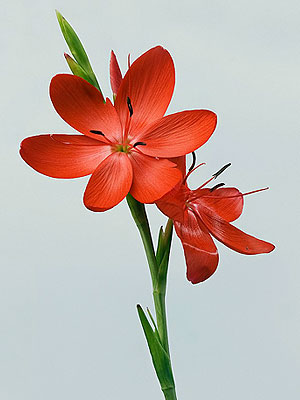
Photo: J. J. Harrison
(under creative commons license (3.0))
http://creativecommons.org/licenses/by-sa/3.0
*********************
edited: 07.11.2017
Lepidochrysops methymna ssp. dicksoni Tite
Dickson’s Dark Opal (Lepidochrysops methymna ssp. dicksoni)
The Monkey Blue is widely distributed in the Eastern- and Western Cape Provinces of South Africa, the species has very high demands concerning the structure of its habitat.
The caterpillars in the first few days of their life feed on two plant species, Pseudoselago serrata (P. J. Bergius) Hilliard and Pseudoselago spuria (L.) Hilliard, hereafter they require the presence of colonies of a special ant species, Liengme’s Camponotus Ant (Camponotus liengmei For.) (or Camponotus maculatus ssp. liengmei For.), in whose anthills they live from the third instar on as brood parasites, feeding on the eggs and larvae of the ants.
***
Dickson’s Monkey Blue, called Tygerberg-bloutjie in Afrikaans, was described in the year 1964. The subspecies was restricted to a very tiny area of only about 4 km² on the northwestern side of the Tygerberg range – this area was converted into agricultural land for wheat farming, whereby both, the food plants as well as the ant colonies were destroyed.
Dickson’s Monkey Blue is now considered extinct.
*********************
References:
[1] G. A. Henning; R. F. Terblanche; J. B. Ball: South African Red Data Book: butterflies. SANBI Biodiversity Series 13. South African National Biodiversity Institute, Pretoria 2009
*********************
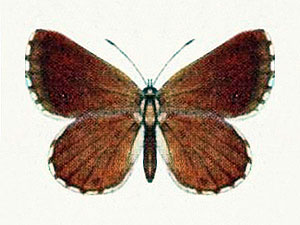
(public domain)
*********************
edited: 14.10.2016
